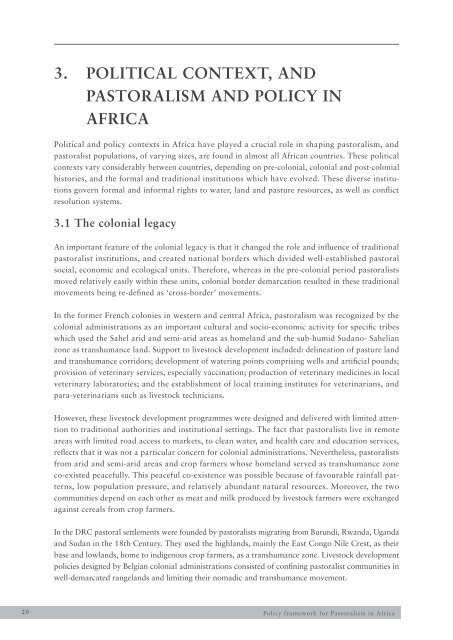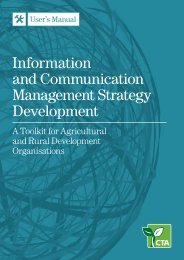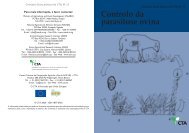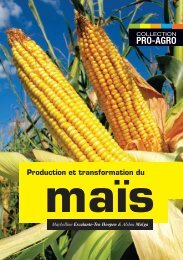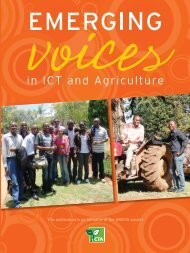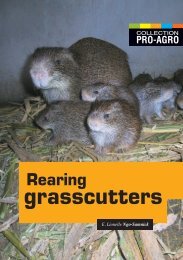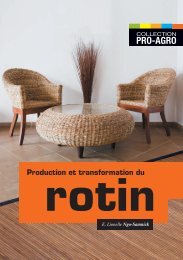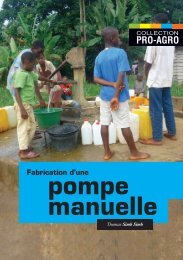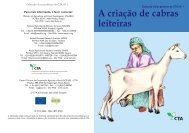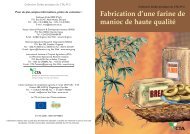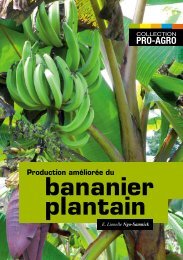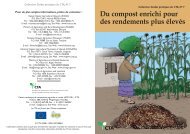to pasture and water resources are often <strong>in</strong>spired by Islamic laws. Typically, pastoral traditiondictates that land is a communal resource.Although conflict between pastoralists and sedentary farmers is commonly reported, there are alsonumerous examples of peaceful co-existence and mutually beneficial economic exchanges. Forexample, pastoral communities based <strong>in</strong> the Sahelian zone can practice transhumance which isbased on peace agreements between their traditional rulers and the traditional rulers of crop farmers.This practice can be seen <strong>in</strong> the common exploitation of pasture land extend<strong>in</strong>g from the wetpla<strong>in</strong>s of the Logone River <strong>in</strong> the far north region of Cameroon to Lake Lere <strong>in</strong> Chad.The social assets of pastoralist groups also <strong>in</strong>clude the <strong>in</strong>digenous social support systems which tovary<strong>in</strong>g degrees, are <strong>in</strong>tended to assist poorer members of the community. These systems may targethouseholds with relative few animals or those which have suddenly lost animals due to disease,flood<strong>in</strong>g or other causes. Female-headed households may also be targeted. These local systems arebased on loans or gifts of livestock or livestock products, and <strong>for</strong> Muslims, the giv<strong>in</strong>g of alms<strong>in</strong>cludes richer households donat<strong>in</strong>g livestock to poorer households.In constrast to these strong aspects of pastoralist culture and social organization are other beliefsand practices which h<strong>in</strong>der development and the <strong>in</strong>tegration of pastoralists <strong>in</strong>to wider society. Someof these features are not restricted only to pastoralists <strong>in</strong> <strong>Africa</strong>, but are also evident <strong>in</strong> variousnon-pastoral areas. A major problem is the low status of women <strong>in</strong> pastoral societies, as evidentfrom statistics on the health and education of pastoral girls and women. Some communities ma<strong>in</strong>ta<strong>in</strong>the tradition of marry<strong>in</strong>g girls of very young age, often to elderly men, with girls sometimesdest<strong>in</strong>ed to their future husbands at birth. The educations of girls can be a taboo and women haveno <strong>in</strong>heritance right, and are isolated from decision-mak<strong>in</strong>g concern<strong>in</strong>g them directly or <strong>in</strong>directly.When women do have the right to own or manage livestock, it can be restricted to sheep and goats,whereas men keep control of more valuable camels and cattle. Female genital mutilation is practiced<strong>in</strong> some pastoralist communities, <strong>in</strong>clud<strong>in</strong>g extreme <strong>for</strong>ms of this practice, with result<strong>in</strong>g lifelonghealth implications <strong>for</strong> women. These health problems are exacerbated by poor access to qualityhealthcare, <strong>in</strong>clud<strong>in</strong>g maternal healthcare.Another serious concern <strong>in</strong> pastoralist areas is conflict. The causes of conflict can <strong>in</strong>clude poorgovernance, but other types of conflict relate to cultural norms among some pastoral groups suchas livestock raid<strong>in</strong>g, or the <strong>for</strong>ced abduction of children from other groups. Historically, manypastoralists have taken occupation of their land by <strong>for</strong>ce, and use <strong>for</strong>ce to access resources dur<strong>in</strong>gdifficult periods. At times violent raid<strong>in</strong>g can be condoned or even organized by the same traditionalleaders who then seek peace us<strong>in</strong>g traditional negotiations.Currently, many pastoral communities are undergo<strong>in</strong>g profound socio-economic and culturaltrans<strong>for</strong>mations <strong>in</strong> the face of moderniz<strong>in</strong>g <strong>Africa</strong>n adm<strong>in</strong>istrations, with vary<strong>in</strong>g degree of success.Generally, government <strong>in</strong>terventions <strong>in</strong>clude promot<strong>in</strong>g <strong>in</strong>tegration of pastoralists <strong>in</strong>to the ma<strong>in</strong>stream through sedentarization, mixed marriages and <strong>in</strong>volvement <strong>in</strong> political processes. As <strong>in</strong>other <strong>Africa</strong>n communities, the social organization and social support systems of pastoralist groupsare not static. In some areas traditional leadership faces pressures from government adm<strong>in</strong>istrationsor disaffected youths, while local safety nets can be weakened when overall livestock hold<strong>in</strong>gs arereduced due to major disease outbreaks, drought or conflict.Secur<strong>in</strong>g, Protect<strong>in</strong>g and Improv<strong>in</strong>g the Lives, Livelihoods and Rights of Pastoralist Communities19
3. Political Context, and<strong>Pastoralism</strong> and <strong>Policy</strong> <strong>in</strong><strong>Africa</strong>Political and policy contexts <strong>in</strong> <strong>Africa</strong> have played a crucial role <strong>in</strong> shap<strong>in</strong>g pastoralism, andpastoralist populations, of vary<strong>in</strong>g sizes, are found <strong>in</strong> almost all <strong>Africa</strong>n countries. These politicalcontexts vary considerably between countries, depend<strong>in</strong>g on pre-colonial, colonial and post-colonialhistories, and the <strong>for</strong>mal and traditional <strong>in</strong>stitutions which have evolved. These diverse <strong>in</strong>stitutionsgovern <strong>for</strong>mal and <strong>in</strong><strong>for</strong>mal rights to water, land and pasture resources, as well as conflictresolution systems.3.1 The colonial legacyAn important feature of the colonial legacy is that it changed the role and <strong>in</strong>fluence of traditionalpastoralist <strong>in</strong>stitutions, and created national borders which divided well-established pastoralsocial, economic and ecological units. There<strong>for</strong>e, whereas <strong>in</strong> the pre-colonial period pastoralistsmoved relatively easily with<strong>in</strong> these units, colonial border demarcation resulted <strong>in</strong> these traditionalmovements be<strong>in</strong>g re-def<strong>in</strong>ed as ‘cross-border’ movements.In the <strong>for</strong>mer French colonies <strong>in</strong> western and central <strong>Africa</strong>, pastoralism was recognized by thecolonial adm<strong>in</strong>istrations as an important cultural and socio-economic activity <strong>for</strong> specific tribeswhich used the Sahel arid and semi-arid areas as homeland and the sub-humid Sudano- Sahelianzone as transhumance land. Support to livestock development <strong>in</strong>cluded: del<strong>in</strong>eation of pasture landand transhumance corridors; development of water<strong>in</strong>g po<strong>in</strong>ts compris<strong>in</strong>g wells and artificial pounds;provision of veter<strong>in</strong>ary services, especially vacc<strong>in</strong>ation; production of veter<strong>in</strong>ary medic<strong>in</strong>es <strong>in</strong> localveter<strong>in</strong>ary laboratories; and the establishment of local tra<strong>in</strong><strong>in</strong>g <strong>in</strong>stitutes <strong>for</strong> veter<strong>in</strong>arians, andpara-veter<strong>in</strong>arians such as livestock technicians.However, these livestock development programmes were designed and delivered with limited attentionto traditional authorities and <strong>in</strong>stitutional sett<strong>in</strong>gs. The fact that pastoralists live <strong>in</strong> remoteareas with limited road access to markets, to clean water, and health care and education services,reflects that it was not a particular concern <strong>for</strong> colonial adm<strong>in</strong>istrations. Nevertheless, pastoralistsfrom arid and semi-arid areas and crop farmers whose homeland served as transhumance zoneco-existed peacefully. This peaceful co-existence was possible because of favourable ra<strong>in</strong>fall patterns,low population pressure, and relatively abundant natural resources. Moreover, the twocommunities depend on each other as meat and milk produced by livestock farmers were exchangedaga<strong>in</strong>st cereals from crop farmers.In the DRC pastoral settlements were founded by pastoralists migrat<strong>in</strong>g from Burundi, Rwanda, Ugandaand Sudan <strong>in</strong> the 18th Century. They used the highlands, ma<strong>in</strong>ly the East Congo Nile Crest, as theirbase and lowlands, home to <strong>in</strong>digenous crop farmers, as a transhumance zone. Livestock developmentpolicies designed by Belgian colonial adm<strong>in</strong>istrations consisted of conf<strong>in</strong><strong>in</strong>g pastoralist communities <strong>in</strong>well-demarcated rangelands and limit<strong>in</strong>g their nomadic and transhumance movement.20 <strong>Policy</strong> <strong>framework</strong> <strong>for</strong> <strong>Pastoralism</strong> <strong>in</strong> <strong>Africa</strong>


